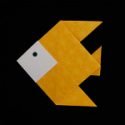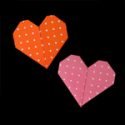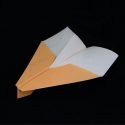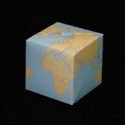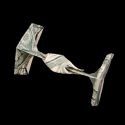Mizuhiki in Relation to Noshi

Mizuhiki is the art of knotting cord into a decorative element. Mizuhiki has nothing to do with origami but it is related to noshi.
Photo: examples of noshi with mizuhiki.
In Japan, noshi is a folded piece of paper which you attach to a gift to confer good luck and auspiciousness. The noshi is held together with a strip of paper or with a mizuhiki. Thus, this page about mizuhiki is an extension on the page about noshi.
When used with noshi, mizuhiki is knotted as a bow or as a loop; its function is to look beautiful and to keep the noshi from unraveling.
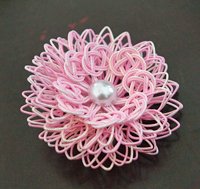
- Gold and silver cord signifies a high class/quality event.
- Red and white signifies a happy, good-luck event.
- Black and white cord is used for funeral or burial ceremonies.
In all cases, the colored cord (red, black, gold) is on the right side and the white (silver) is on the left; for example, see below.
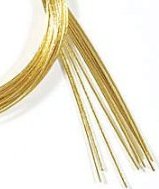
- Musubikiri: this knot is tied tightly and it not meant to be untied. This symbolizes an event which you wish to do once and not do again. You would use this for a wedding or for a funeral since these are once-in-a-lifetime events. The cords would be dyed black & white for funerals.
- Hanamusubi: this is a butterfly knot which can easily be tied and untied. This type of knot is used for celebrations which can occur again and again such as birthdays or job promotions.
- Awajimusubi: this knot is loosely wound into loops. If you pull at the ends of the cord, the loops will be smaller and closer together. This type of knot is used to symbolize “growing together”; for example, in a business partnership or an engagement. Knot can be used for sad events such as get well wishes because it involves growing better.
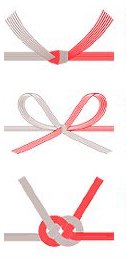
Cylindrical objects are bound with mizuhiki with one loop whereas flat packages use mizuhiki with two loops. Wedding gifts often have two or more loops. In funerals, the loops are deliberately cut to give jarring ends. there is nothing lucky about being dead.
There is much to know about Japanese culture and tradition. It is advisable that you consult someone in the know so you don’t accidentally use the wrong kind of mizuhiki at the wrong time.
Read about Noshi
History of Origami
Home Page
more Origami Instructions
Site Map
-
Books with Easy Origami
- Easy Origami: over 30 simple projects by John Montroll
- Origami Fun Kit for Beginners by John Montroll
- My First Origami Kit by Joel Stern
- Easy Origami: A Step-by-Step Guide for Kids by C Alexander & M Meinking
- Fun With Easy Origami (Dover Origami Papercraft)
- Origami: A Step-by-Step Introduction to the Art of Paper Folding by T Cook & S Henry
- Easy Origami For Kids Book Traditional Japanese Folding Papers Overs 20 Projects by J Wish
- Easy Origami for Kids: Over 40 Simple Origami Projects by O Brooks
Please Help
Please help by reporting broken links so that we can fix them. One easy message from you can save us hours and hours of clicking. Thanks!
-
More Origami Diagrams and Instructions…
-
These free origami instructions are made available to you by the paper folding community at large. If you have a diagram you would like to share, or if your diagram is listed here and you wish to have it removed, please Contact Us. Diagrams are intended for personal use. Copyright of the models lie with the origami creators and designers. Please contact the designer and/or creator directly for non-private usage of a model and/or artwork.









